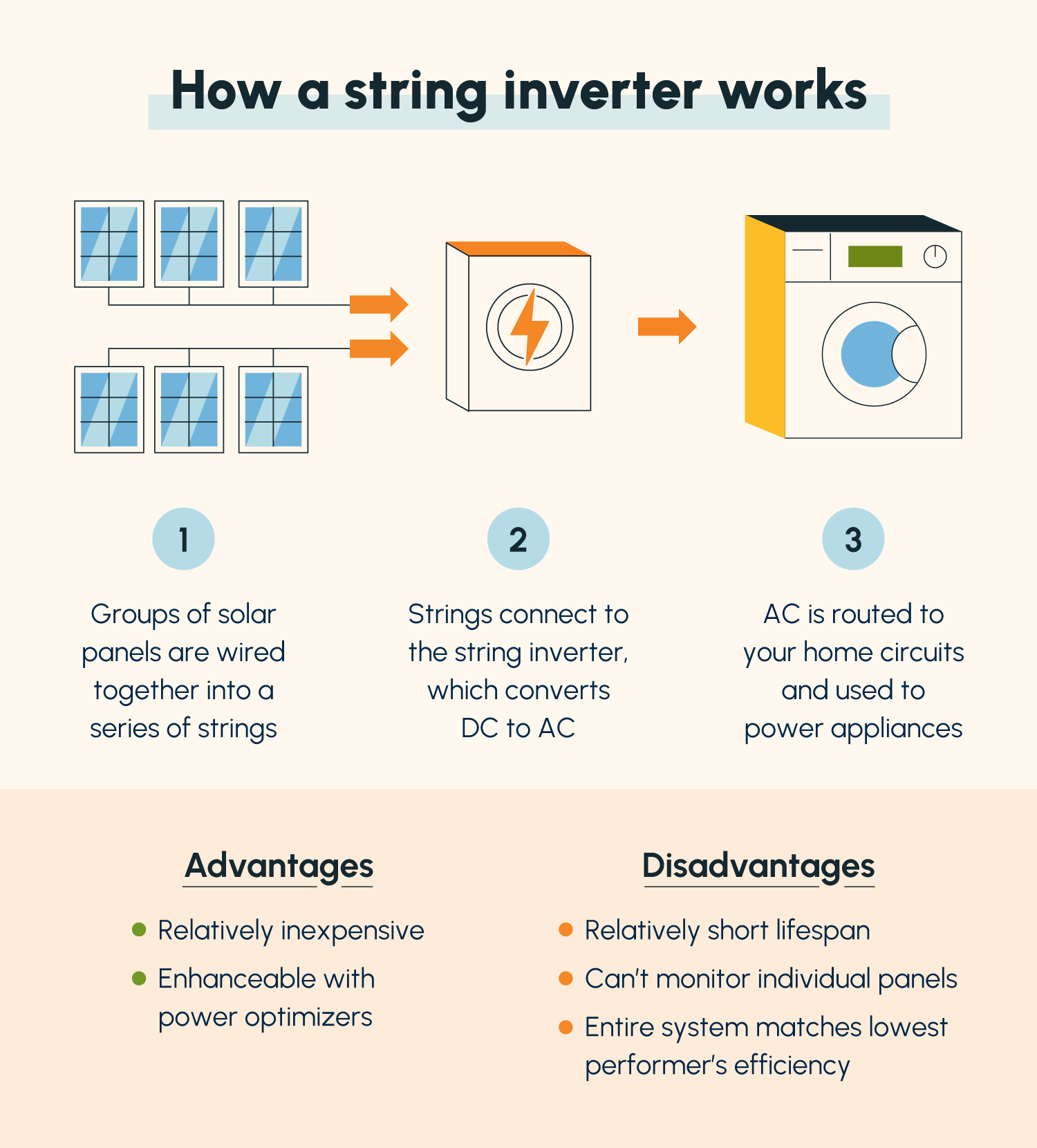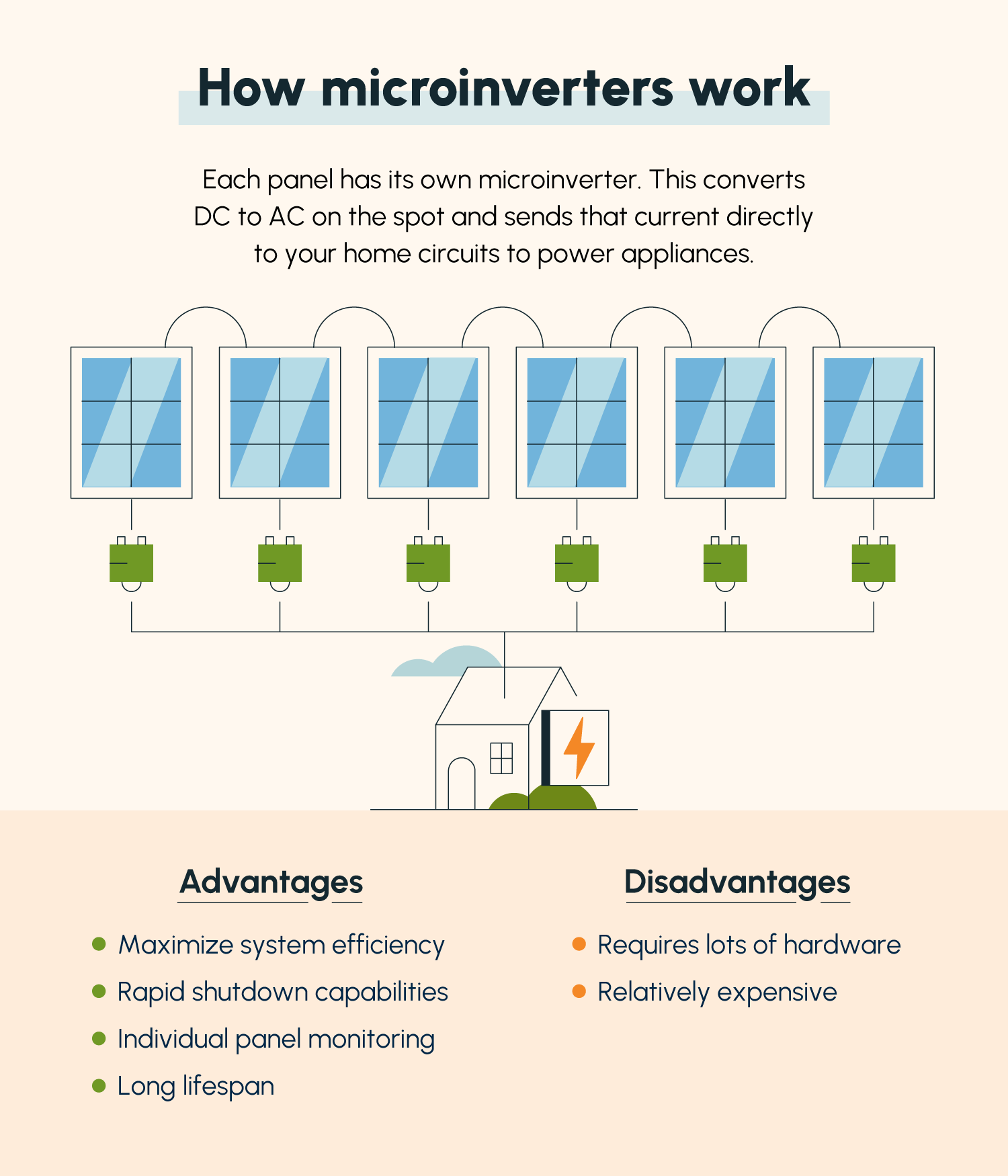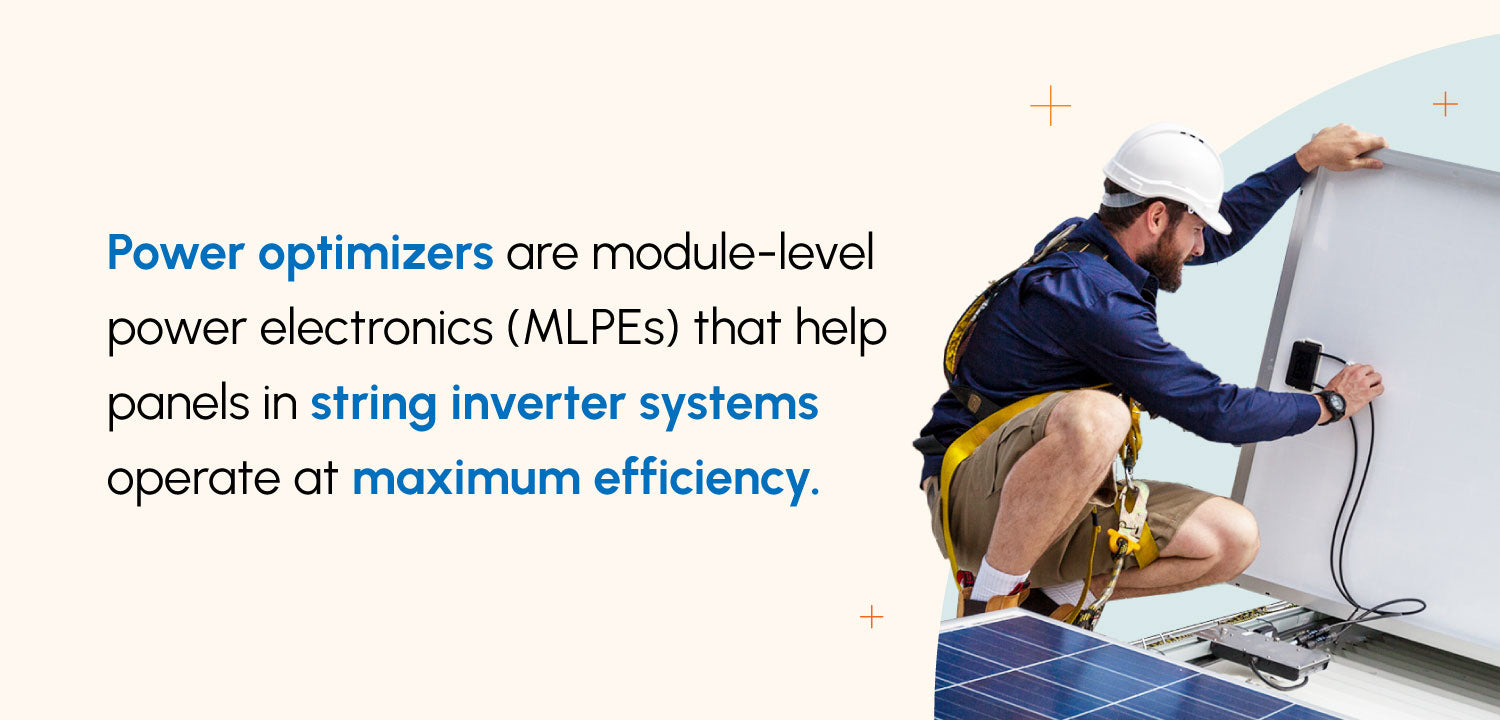Solar inverters are an essential part of any solar system. Without them, the energy our solar panels generate wouldn’t be usable.
Solar panels generate direct current (DC), whereas home appliances rely on alternating current (AC) to function. Solar inverters take the DC generated by solar panels and convert it into AC, which can then be used to power lights, appliances, electronics, and anything else that requires electricity to function.
As soon as you start researching solar inverters, you’ll become aware of the microinverter vs. string inverter debate. While both types of inverters effectively convert DC to AC, they have some key differences.
Simply put, microinverters make each panel its own self-sufficient system whereas string inverters link entire solar systems, making one panel’s performance dependent on the others.
In this guide, we compare microinverters, string inverters, and alternatives like hybrid inverters so that you can choose the right option for your solar system.
What Is a String Inverter?

A string inverter is a type of central inverter that receives solar panel inputs in strings (or groups) and converts their currents from DC to AC. An entire solar system is usually managed by only one or two string inverters.
Each “series string” usually consists of six to 12 individual solar panels wired together. The end of this chain is then connected to the string inverter.
String inverters usually have multiple inputs, allowing you to connect several strings to a single inverter. For example, if you have 24 panels and an inverter with four inputs (and a sufficient input voltage rating), you can create four strings of six panels each and use one inverter for your entire system.
String Inverter Advantages
String inverters have been used in solar systems for decades. In addition to their reliability, string inverter systems offer several benefits.
Low Cost
Installing a string inverter tends to be less expensive than installing microinverters.
As we’ll discuss in greater detail later, a microinverter system requires you to purchase as many microinverters as you have solar panels. For a string inverter system, most households only need to buy one inverter. This also means less time and energy spent installing your inverter system.
Optimizer Compatibility
String inverters can be paired with power optimizers to improve their efficiency and decrease the effect that a less powerful panel has on the entire series. In the event that one panel’s view of the sun is obstructed, power optimizers help the system continue generating energy efficiently.
Since most existing older systems use a string inverter, optimizers are often added to string systems post-installation to make them behave more like microinverters, which we’ll discuss in greater detail later on.
String Inverter Disadvantages
String inverters do have some limitations, which we outline below.
Solar Panel Interdependence
With string inverters, each string of panels is only as good as its weakest link. If one panel in a string malfunctions, all of the panels in that string malfunction. If shade or cloud coverage negatively impacts one panel’s efficiency, all other panels in its string are equally affected unless you’ve connected costly power optimizers to each of your panels.
For example, let’s say your panels operate at 350W during peak sun hours. If one panel gets obstructed or malfunctions and starts producing at 280W, every panel in the series string will follow suit and produce at 280W.
Likewise, if an entire string inverter goes down, the strings connected to that inverter will follow suit. However, if you have multiple string inverters, each with their own strings of panels, one inverter’s failure won’t impact the other inverter’s strings — just the strings attached to the powered-down inverter.
Shorter Lifespan
String inverters have a relatively short lifespan, lasting only 12-15 years. Their warranties tend to be even shorter — about five to 12 years.
Since solar systems can last for up to 30 years, there’s a good chance you’ll have to replace your string inverter during your system’s lifetime. It’s important to budget to replace your string inverter so that you don’t end up with a surprising expense.
No Individual Panel Monitoring
String inverter systems don’t allow panel-level monitoring. You can only see aggregate solar production as opposed to individual panel performance.
This means that if one panel is having an issue generating energy, whether that be due to shade, damage, or a malfunction, it can be challenging to figure out which one is the source of the issue. Unlike inverter troubleshooting, panel troubleshooting isn’t very straightforward.
What Is a Microinverter?

As the name suggests, a microinverter is a small inverter installed under each solar panel on your roof. Since there’s a microinverter for every solar panel, these are considered module-level power electronics (MLPEs).
Microinverters are usually about the size of internet routers and perform the same job as any other inverter — converting panel-generated DC into usable AC.
Unlike string inverters, where you only need one or two for your entire system, you usually need the same number of microinverters as you have solar panels since each panel needs its own inverter. That said, there are certain microinverters that can connect to two to four panels.
Each panel and microinverter pair is its own energy generation and current conversion system. This means that each panel can operate at its full potential without being impacted by the performance of other panels, unlike string inverter systems.
Microinverter Advantages
Being a newer technology, microinverters have some unique capabilities that string inverters lack. Let’s discuss some of these advantages.
Higher Electricity Yield
As previously mentioned, microinverter performance isn’t limited by panels that aren’t performing at their maximum efficiency.
If one panel is struggling to produce the highest current possible, that doesn’t impede other panels’ ability to do so. This results in a generally higher electricity yield than string inverter systems.
Longer Lifespan
Microinverters tend to have much longer warranties than string inverters, lasting about as long as a solar system’s average lifespan — 25 years.
While the reliability of microinverters was questioned by solar customers initially, the length of the average microinverter warranty speaks to manufacturers’ confidence in their product.
Fit For Rapid Shutdown
Rapid shutdown is an electrical safety requirement established by the National Electrical Code (NEC) to ensure solar panels can be shut off at a moment’s notice. It was established to protect firefighters and responders who climb buildings with high-voltage solar panels.
As a newer technology, microinverters come equipped with rapid shutdown capability. String inverters usually need an add-on to be compliant with this requirement.
Individual Panel Insights and Tracking
Since standard inverters string panels together into a series, you can only track the performance of the system as a whole.
With a microinverter system, on the other hand, since each panel has its own inverter, you can track the performance of each individual panel and diagnose any inefficiencies much more easily.
Microinverter Disadvantages
While more technologically advanced, microinverters do come with some drawbacks.
Higher Cost
Microinverters fall on the pricier side of inverter technology. Typically, microinverters cost about 35% more than string inverters on a dollar-per-Watt basis.
Unless you’re planning to add power optimizers to your string inverter system (which we’ll discuss in detail later), you’ll be spending significantly more if you choose microinverters.
Challenging Maintenance
In the event of a string inverter malfunctioning or breaking, the worst case scenario is replacing it with a new inverter on the side of your house.
While it’s easy to identify which microinverter isn’t working using a monitoring software, having a technician scale your roof to fix or replace the malfunctioning inverter can be a hassle.
Intensive Hardware
Since every panel in your system needs a microinverter for the system to function, you’re putting a lot of expensive equipment on your roof with a microinverter setup. In the event of severe weather, that hardware may be at risk.
What Are Power Optimizers?

Power optimizers, much like microinverters, are MLPEs that can be attached to each individual solar panel to ensure every panel is operating at its own maximum potential.
They’re designed to solve the issue of string inverter interdependence by helping each panel perform efficiently regardless of whether another panel in the series string is under-producing.
As previously mentioned, they are usually added to string inverter systems once the homeowner realizes that shade or panel orientation inhibits the system’s efficiency.
Microinverter vs. Optimizer: Which Is Better?
Microinverters and power optimizers perform a very similar function. They’re both MLPEs that are designed to improve solar system efficiency.
The difference comes down to the average warranty of each type of system.
Optimizers attach to string inverters, which usually have a much shorter warranty than microinverters. Even if your optimizers last, you may need to replace your string inverter system during your solar system’s lifetime.
From a logistical standpoint, microinverters will likely cause less of a headache.
Of course, if your roof isn’t shaded and you’re investing in high-quality panels that aren’t likely to malfunction, you probably don’t need to invest in any MLPEs at all. A string inverter without any optimizers should do just fine.
What Is a Hybrid Inverter?
If you plan to add one or more battery packs to your system to store surplus energy for times of low solar production, a hybrid inverter is another inverter alternative that could save you money and hassle.
A hybrid inverter operates as both a solar inverter and a battery inverter. This means that it converts the current from solar panels from DC to AC for use in household appliances and the grid, while also converting AC from the grid into DC to be stored in solar batteries. Due to their versatility, hybrid inverters can perform the same function for systems using AC batteries.
In short, with a hybrid inverter, you don’t have to invest in both a solar inverter (string or microinverter) and a battery inverter, as this inverter contains both.
Some advantages of a hybrid inverter include monitoring capability for both panels and batteries as well as supplying energy during grid outages. Some disadvantages include relatively high equipment cost and a complicated rewiring process when adding a hybrid inverter to an existing system.
Microinverter vs. String Inverter vs. Hybrid Inverter: Which Should You Choose?

The type of inverter(s) you choose depends on your individual situation. Take the following considerations into account as you decide which option is right for you.
- Shading: If you have shading issues where your panels will be installed, microinverters will help you get the most out of your system. If your roof has no shade, a string inverter should perform perfectly.
- Panel orientation: If some panels in a string system don’t face south, this can diminish your other panels’ efficiency. Microinverters might give you greater return if you will have suboptimal panel orientation.
- Battery usage: If you know you’ll be using a battery system before you build out your system, a hybrid inverter might be right for you. It reduces equipment needs and hassle by combining a solar and battery inverter into one device.
- Compliance requirements: If you must comply with rapid shutdown requirements, microinverters make compliance easier because they have the mechanism required to shut down your panels built into them. Check your local codes before choosing a string inverter.
- System size: String inverters are the more cost-effective option for large systems. If you plan to install a very large system with minimal shading, you may want to consider a string inverter. That said, string inverter systems are not easy to expand since each string inverter only accepts a certain voltage level from a certain number of panels. If you anticipate adding more panels down the road, microinverters are probably the better option.
If none of the above considerations raise concern, you may be better off with the more cost-effective option: a string inverter system.
Solar Inverter FAQ
Choosing an inverter is a very important part of setting up your solar system, so it’s important to have all of your questions answered before making a purchase. Below, we unpack a few more common questions about inverters.
What Is a Central Inverter?
A central inverter is a large grid feeder that converts the energy produced by several solar panels from a direct current (DC) to an alternating current (AC). As the name suggests, it is the central “hub” of the solar system, where all panels connect.
A string inverter is a type of central inverter that receives panel inputs in groups or strings. Central inverters that don’t receive strings are typically used for utility applications as opposed to residential applications and tend to be more technical.
How Does a Microinverter Work?
A microinverter connects to the back of a solar panel, converting its current from DC to AC on the spot before sending that electricity to your fuse box.
This differs from a string inverter system, where panels are strung together and all of their DCs are converted to ACs in the same inverter before that electricity is sent to your fuse box.
Are Microinverters Reliable?
As long as you invest in high-quality microinverters, it’s unlikely that they will fail. Most have undergone rigorous testing in a variety of weather conditions to confirm their integrity and reliability.
Even if they do fail, there’s very little risk, as most manufacturers place extensive warranties (about 25 years long) on their microinverters and will replace broken ones.
With Solartap, inverter reliability and cost will be the least of your worries. No matter which type of inverter you settle on, we have you covered.
Explore our offerings and get your solar system up and running today.

